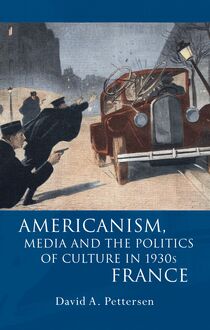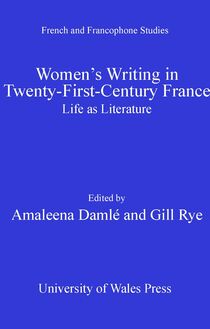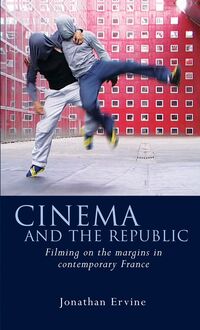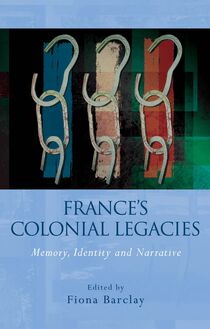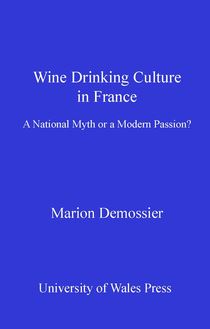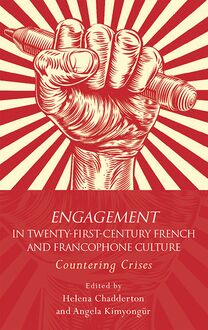Cinema and the Republic , livre ebook
108
pages
English
Ebooks
2013
Vous pourrez modifier la taille du texte de cet ouvrage
Obtenez un accès à la bibliothèque pour le consulter en ligne En savoir plus
Découvre YouScribe en t'inscrivant gratuitement
Découvre YouScribe en t'inscrivant gratuitement
108
pages
English
Ebooks
2013
Vous pourrez modifier la taille du texte de cet ouvrage
Obtenez un accès à la bibliothèque pour le consulter en ligne En savoir plus
Publié par
Date de parution
15 mai 2013
Nombre de lectures
2
EAN13
9781783165537
Langue
English
This book analyses contemporary French films by focussing closely on cinematic representations of immigrants and residents of suburban housing estates known as banlieues. It begins by examining how these groups are conceived of within France's Republican political model before analysing films that focus on four key issues. Firstly, it will assess representations of undocumented migrants known as sans-papiers before then analysing depictions of deportations made possible by the controversial double peine law. Next, it will examine films about relations between young people and the police in suburban France before exploring films that challenge cliches about these areas. The conclusion assesses what these films show about contemporary French political cinema.
Publié par
Date de parution
15 mai 2013
Nombre de lectures
2
EAN13
9781783165537
Langue
English
FRENCH AND FRANCOPHONE STUDIES
Cinema and the Republic
Series Editors
Hanna Diamond (University of Bath)
Claire Gorrara (Cardiff University)
Editorial Board
Ronan le Coadic (Universit Rennes 2)
Nicola Cooper (Swansea University)
Didier Francfort (Universit Nancy 2)
Sharif Gemie (University of Glamorgan)
H. R. Kedward (Sussex University)
Margaret Majumdar (University of Portsmouth)
Nicholas Parsons (Cardiff University)
Max Silverman (University of Leeds)
FRENCH AND FRANCOPHONE STUDIES
Cinema and the Republic
Filming on the Margins in Contemporary France
JONATHAN ERVINE
CARDIFF UNIVERSITY OF WALES PRESS 2013
Jonathan Ervine, 2013
All rights reserved. No part of this book may be reproduced in any material form (including photocopying or storing it in any medium by electronic means and whether or not transiently or incidentally to some other use of this publication) without the written permission of the copyright owner except in accordance with the provisions of the copyright, designs and patents act 1988. Applications for the copyright owner s written permission to reproduce any part of this publication should be addressed to the University of Wales Press, 10 Columbus walk, Brigantine place, Cardiff, CF10 4UP.
www.uwp.co.uk
British Library Cataloguing-in-Publication Data A catalogue record for this book is available from the British Library.
ISBN 978-0-7083-2596-4
e-ISBN 978-1-78316-553-7
The right of Jonathan Ervine to be identified as author of this work has been asserted by him in accordance with sections 77 and 79 of the Copyright, Designs and Patents Act 1988.
Cover illustration: On n est pas des marques de v lo (2002), directed by Jean-Pierre Thorn.
Contents
Series Editors Preface
Acknowledgements
Introduction
Chapter One: Cinema and the Republic
Chapter Two: The Sans-papiers on Screen - Contextualising Immigrant Experiences in Film
Chapter Three: Double peine: The Challenges of Mobilising Support for Foreign Criminals via Cinema
Chapter Four: Challenging or Perpetuating Clich s? Young People and the Police in France s Banlieues
Chapter Five: Challenging Stereotypes about France s Banlieues by Shifting the Focus?
Conclusion
Notes
Filmography and Bibliography
Series Editors Preface
This series showcases the work of new and established scholars working within the fields of French and francophone studies. It publishes introductory texts aimed at a student readership, as well as research-orientated monographs at the cutting edge of their discipline area. The series aims to highlight shifting patterns of research in French and francophone studies, to re-evaluate traditional representations of French and francophone identities and to encourage the exchange of ideas and perspectives across a wide range of discipline areas. The emphasis throughout the series will be on the ways in which French and francophone communities across the world are evolving into the twenty-first century.
Hanna Diamond and Claire Gorrara
Acknowledgements
Writing a book can, as with shooting a film, involve a long journey. The journey that has ultimately produced this book is one that began thanks to the inspiring French classes of Mr Grove and Mr Jessop whilst I was a school pupil at Madras College in St Andrews. It was then that I was introduced to French cinema and politics before deciding to study French at the University of Leeds. I would like to express my gratitude to several former colleagues at Leeds, and especially Diana Holmes and Jim House for supervising my doctoral studies. Many others provided support and advice along the way, including Margaret Atack, David Looseley, Kamal Salhi and Max Silverman. For their answers to questions, feedback on conference papers, help in finding difficult-to-obtain films, insight, knowledge, advice and providing accommodation on research trips to France, thanks are also due to many colleagues, friends and people whose work I studied: Mogniss Abdallah, Sylvie Agard, Maggie Allison, Moustapha Amokrane, Sa r Maty B , Patrice Bouche, Olivier Esteves, Aline Goudenhooft, Owen Heathcote, Will Higbee, Cristina Johnston, Geoff Medland, Martin O Shaughnessy, Joel Saurin, Carole Sionnet, Carrie Tarr, Jean-Pierre Thorn, Carol Tully and Isabelle Vanderschelden.
There are innumerable others who also provided help and advice, not least at several conferences organised by the Association for the Study of Modern and Contemporary France. The School of Modern Languages at Bangor University has provided a highly convivial environment in which to work over the last six years and I am extremely grateful to my numerous colleagues whose presence creates such a positive atmosphere. I would very much like to express my gratitude towards University of Wales Press for its encouragement and support, especially to the anonymous reader for their constructive feedback and suggestions, and also to Sarah Lewis and Si n Chapman for coordinating everything in such an efficient and helpful manner.
My parents have also been a source of limitless support and encouragement over the years in ways that are far too numerous to list here, and this is something for which I will forever be grateful. Finally, I would like to thank Viv for her support, encouragement and good humour while I have been finalising this work.
Jonathan Ervine March 2013
Introduction
The year 1995 was highly significant for both political protest and political cinema in France. Whilst the mass demonstrations that took place in this year initially focused primarily on opposing pension reforms, the movement swiftly sought to provide a more generalised criticism of Alain Jupp s government. Martin O Shaughnessy argues that it was the mass mobilisations of 1995 which signalled a change of the socio-political climate in France, and which created the conditions for the rebirth of a committed cinema and for subsequent mobilisations such as that around the sans-papiers . 1 This newly re-engaged model of film-making lacked a unifying political discourse. This constituted a significant difference from earlier political cinema in France, but its lack of homogeneity did not obscure the fact that it was nevertheless characterised by an identifiable spirit of revolt . 2 This revolt has often involved directors filming people who live, or are perceived to live, on the margins of French society due to factors such as their status as immigrants or the fact that they have grown up on suburban housing estates known as banlieues.
In order to trace the processes that explain how and why immigrants and banlieue residents are often seen as living on the margins in contemporary France, 1 will focus on the period since 1995. This time has been punctuated by major socio-political events to which both protesters and film-makers have sought to respond. In addition to the mass public-sector strikes already mentioned, 1995 also saw Jacques Chirac become French president after fighting a campaign in which he often evoked the theme of la fracture sociale (social disintegration). Ten years later, the deaths of two young men in a police chase in Clichy-sous-Bois provoked widespread protests in France s banlieues. A year and a half later, Nicolas Sarkozy became France s head of state and his presidency saw the ruling centre-right UMP ( Union pour un mouvement populaire, Union for a Popular Movement) party take an increasingly tough approach to controlling immigration and policing France s banlieues. This occurred against the backdrop of the far-right Front National remaining a significant and powerful force in French politics following both Jean-Marie Le Pen s coming second in the 2002 presidential elections and his daughter Marine Le Pen s subsequent inauguration as its new leader in 2009. Marine Le Pen s leadership of the Front National, and particularly her campaign for the 2012 presidential elections, have seen the party present itself as being more modern and mainstream. Following Sarkozy s defeat in the presidential elections and the potential for splits within his centre-right UMP following its poor showing in the 2012 legislative elections, the Front National may well continue to play an ever more important role in shaping right-wing politics in France.
As the years following 1995 have seen both left- and right-wing governments in power, this period permits comparison of how filmmakers have sought to represent socio-political issues in France in differing political contexts. In this book, I will study works that involve directors filming people who are perceived to be living on the margins of contemporary French society. This will entail focusing on how and why certain immigrants are unable to access the full range of rights that are granted to French citizens and also the processes of exclusion that often stigmatise residents of the banlieues.
I will provide close analysis of films that address four specific politically resonant issues that concern how these often marginalised groups interact with the state and the media in France:
1. The status of sans-papiers (undocumented migrants) in France.
2. Attempts to defend foreign nationals subjected to the double peine (double penalty) law.
3. Relations between young people and the police in France s banlieues.
4. Representations of communal activities and daily life in France s banlieues.
The films that are grouped together within these chapters have been selected on a primarily thematic basis that brings several significant yet under-studied works to the fore. Using the themes listed above to define the corpus helps to shape what could have been a potentially vast corpus by paying particular attention to films that focus on power relations. The first two themes listed above provide a means of selecting films that are particularly relevant to specific immigrant rights campaigns and the second two make it possible to assess how the evolution of power relations issues in s



